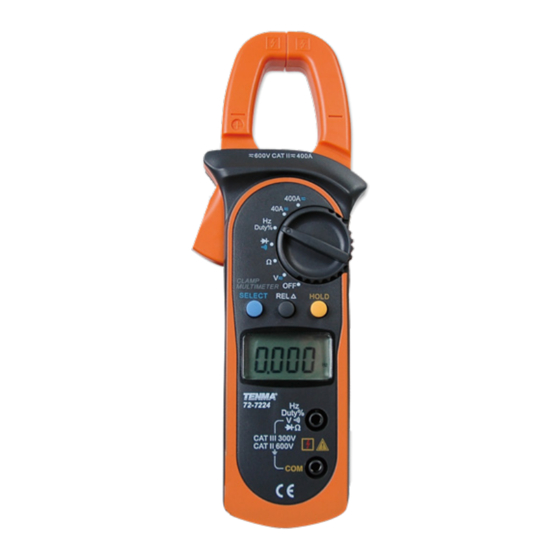Advertisement
Advertisement
Table of Contents

Summary of Contents for Tenma 72-7224
- Page 1 Digital Clamp Meter Model: 72-7224 & 72-7226...
-
Page 2: Safety Information
SAFETY INFORMATION Please read these instructions carefully before use and retain for future reference. This meter is designed to meet IEC61010-1, 61010-2-032, and 61010-2-033 in Pollution Degree 2, Measurement Category (CAT II 600V, CAT III 300V) and double Insulation. • Do not operate the meter or use test leads if they appear damaged, or if the meter is not operating properly. -
Page 3: Symbol Guide
SYMBOL GUIDE AC (Alternating Current) DC (Direct Current) AC or DC Grounding Double insulated Warning Low battery Continuity Buzzer Diode Fuse Application around and removal from UNINSULATED HAZARDOUS LIVE conductors is permitted. Conforms to European Union directives This symbol signifies the product complies with both USA and Canada requirements. -
Page 4: Operating Parameters
OPERATING PARAMETERS • Operating temperature: 23°C± 5°C • Relative Humidity: ≤85%. • Temperature Coefficient: 0.1× (specified accuracy)/1°C DC VOLTAGE Range Resolution Accuracy Overload Protection 400.0mV 0.1mV ±(0.8%+3) 4.000V 40.00V 10mV ±(0.8%+1) 600V DC/AC 400.0V 100mV 600V ±(1%+3) Note: The input impedance is 10MΩ. AC VOLTAGE Range Resolution... -
Page 5: Duty Cycle
DIODE AND CONTINUITY Range Resolution Accuracy Overload Protection Displays approximate 600Vp forward voltage drop Note: The open circuit voltage is about 1.48V. Range Resolution Accuracy Overload Protection When ≤10Ω, the 100mΩ 600Vp buzzer beeps. Notes: • The open circuit voltage is about 0.45V. •... - Page 6 DC CURRENT Range Resolution Accuracy Overload Protection 40.00A 0.01A ±(2%+5) 400A DC/AC 400.0A 0.1A ±(2%+3) Notes • If the reading is positive, the current direction is from down to up (See Figure 10, with the front panel facing up, and rear panel facing down). •...
-
Page 7: Operation
OPERATION Measuring DC/AC Voltage • The DC voltage ranges are 400mV, 4V, 40V, 400V and 600V. • The AC voltage ranges are 4V, 40V, 400V and 600V. • To measure DC/AC voltage, perform the following steps: Insert the red test lead into the Hz Duty% terminal and the black test lead into the COM terminal. -
Page 8: Diode Check
DIODE CHECK • Use the diode test mode to check diodes, transistors and other semiconductor devices. In diode test mode, a current is sent through the semiconductor junction and the voltage drop across the junction is measured. • A good silicon junction drop is between 0.5V and 0.8V. •... -
Page 9: Frequency Measurement
FREQUENCY MEASUREMENT • The frequency ranges are 10Hz, 100Hz, 1kHz, 10kHz, 100kHz, 1MHz and 10MHz. • To measure frequency, perform the following steps: Insert the red test lead into the Hz Duty% terminal and the black test lead into the COM terminal. Turn the rotary switch to Hz. -
Page 10: Dc/Ac Current Measurement
• The operating temperature must be 0ºC ~40ºC when measuring current. Change to AC: Model: 72-7224: • Change to AC by using average response method. • Input sine wave, then adjust the reading until it is same as the effective value. -
Page 11: Maintenance
MAINTENANCE Replacing the battery • When the meter displays the low battery symbol, replace the battery Screw immediately in order to maintain normal operation. • Disconnect and remove all test probes Battery from any live source and the meter. • Open the battery cover on the rear case with a screwdriver. - Page 12 INFORMATION ON WASTE DISPOSAL FOR CONSUMERS OF ELECTRICAL & ELECTRONIC EQUIPMENT These symbols indicate that separate collection of Waste Electrical and Electronic Equipment (WEEE) or waste batteries is required. Do not dispose of these items with general household waste. Separate for the treatment, recovery and recycling of the materials used. Waste batteries can be returned to any waste battery recycling point which are provided by most battery retailers.

















Need help?
Do you have a question about the 72-7224 and is the answer not in the manual?
Questions and answers